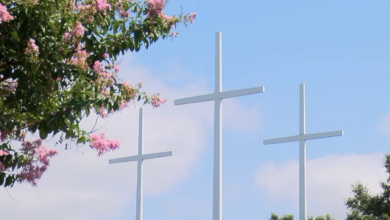Paris exhibit recalls Notre-Dame’s history of restorations, modifications

By Lydia Hernandez Tellez
Paris, Feb 14 (EFE).- Prior to the scheduled 2024 reopening of Notre-Dame, a new exhibit in the French capital is looking back at the more than eight-century history of that famed medieval Catholic cathedral and its history of restoration projects and other more minor modifications.
An icon of French Gothic architecture located on an island in the Seine River and one of Paris’ most visited tourist sites, the cathedral’s importance was evident in the “emotional reaction” and worldwide interest in the wake of the devastating April 15, 2019, fire, Isabelle Marquette, curator of the “Des battiseurs aux restaurateurs” (From the Builders to the Restorers) exhibit that will open on Wednesday, told Efe.
That blaze not only caused “a big emotional shock,” but also destroyed emblematic features such as its central spire and wooden ceiling structure, she recalled.
Those elements have been gradually rebuilt, so that by 2024 a new Notre-Dame will be unveiled that is virtually identical to the version of the cathedral that existed prior to the fire.
But before that grand reopening, the exhibit at Paris’ Cite de l’architecture et du patrimoine, a museum of architecture and monumental sculpture, will trace the cathedral’s history and provide visitors a chance to admire sculptures, frescoes and stained-glass windows that at one time were part of Notre-Dame.
Constructed in the 12th century, Notre-Dame was built on the site of a large early Christian church, the Cathedral of Saint Etienne.
Work was begun in 1163 under Bishop Maurice de Sully, who, according to Marquette, sought to bestow the building with a “new and poetic style.”
The first version of Notre-Dame was completed in the mid-13th century with the construction of the cathedral’s original timber spire, which was used as a bell tower, although by that point it had already undergone several modifications, including an enlargement of its high windows to accentuate the entry of light.
Centuries later, the destruction caused by the French Revolution in the 1790s left the cathedral in a ruinous state, with its statues and religious imagery damaged or destroyed and its bronze, lead and precious metals melted down.
It was also at that time that the spire had become so badly damaged that it was on the verge of collapse and had to be dismantled.
Decades later, Victor Hugo’s 1831 novel “The Hunchback of Notre-Dame” sparked renewed interest in the cathedral and led to a broader push to protect France’s cultural heritage.
Numerous intellectuals, including painter Jean-Auguste-Dominique Ingres and Hugo himself, were among the signatories of a petition to save the monument, which was fully restored over 20 years under the supervision of architects Jean-Baptiste Lassus and Eugene Viollet-le-Duc.
The centerpiece of their work was a new spire that was thinner than the previous one and had a purely ornamental function.
Recently, in the wake of the 2019 fire, a new debate was launched on whether the goal of this latest restoration work should be to modernize the cathedral or return it to its prior state.
Finally, by unanimous vote of France’s National Heritage and Architecture Commission, a decision was made to restore the building’s previous appearance.
That meant using the cathedral’s original materials (stone for its vaulted ceilings, oak for the framework of the central spire and lead for the ornament coverings), as well as Viollet-le-Duc’s original spire designs.
The exhibit at the Cite de l’architecture et du patrimoine also recounts this latest chapter in the history of Notre-Dame, reviewing the painstaking work carried out over the past three years by carpenters, restorers, blacksmiths and other artisans.
Those professionals also were accompanied by a team of researchers tasked with expanding existing knowledge about the cathedral.
In addition, the “Des battiseurs aux restaurateurs” exhibit includes sculptures, stained-glass windows and paintings that have been restored and will return to Notre-Dame in 2024, as well as parts of the great organ, which is to be reassembled and tuned over a period of several months at the start of next year. EFE





